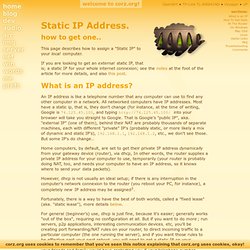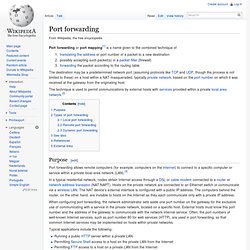

Get A Static IP! How to set a static ip address for your computer (for p2p, web servers, bittorrent, etc) for Linux, Windows, and Mac. Corz.org uses cookies to remember that you've seen this notice explaining that corz.org uses cookies, okay!

This page describes how to assign a "Static IP" to your local computer. If you are looking to get an external static IP, that is; a static IP for your whole internet connexion; see the notes at the foot of the article for more details, and also this post. What is an IP address? An IP address is like a telephone number that any computer can use to find any other computer in a network. All networked computers have IP addresses. Home computers, by default, are set to get their private IP address dynamically from your gateway device (router), via dhcp, In other words, the router supplies a private IP address for your computer to use, temporarily (your router is probably doing NAT, too, and needs your computer to have an IP address, so it knows where to send your data packets).
Fortunately, there is a way to have the best of both worlds, called a "fixed lease" (aka. Okay, let's do it! 1. Static IP Address - Using Static IP Addresses on Private Networks. PC Network Defense. DDoS attacks made worse by firewalls, report finds. February 02, 2011, 8:50 AM — The rising tide of distributed denial of service attacks (DDoS) is being made much worse by a tendency to mis-deploy firewalls and intrusion prevention systems (IPS) in front of servers, a report by Arbor Networks has found.

The company surveyed 111 global service providers across fixed and mobile sectors for its 2010 Infrastructure Security Report and uncovered a huge jump in DDoS attack size during the year. Maximum attack sizes reached 100Gbit/s for the first time, double that for 2009, and ten times the peak size seen as recently as 2005, increasingly in the form application attacks rather than simple packet flooding.
Attack frequency also appears to be increasing, with 25% of respondents seeing 10 or more DDoS attacks per month, and 69% experiencing at least one. [ Related: Just say No to DDOS attacks ] "They [firewalls] should not be placed in front of servers. "They don't have visibility into their IP network. Free Proxy - Surf Anonymously & Hide Your IP Address. Get Behind the Shield! Hotspot Shield by AnchorFree.
PortForward.com - Port Forwarding Guides Listed by Manufacturer and Model. Free Help Setting up Your Router or Firewall. Port forwarding. Port forwarding or port mapping[1] is a name given to the combined technique of translating the address or port number of a packet to a new destinationpossibly accepting such packet(s) in a packet filter (firewall)forwarding the packet according to the routing table.

The destination may be a predetermined network port (assuming protocols like TCP and UDP, though the process is not limited to these) on a host within a NAT-masqueraded, typically private network, based on the port number on which it was received at the gateway from the originating host. The technique is used to permit communications by external hosts with services provided within a private local area network.[2] Purpose[edit] Port forwarding allows remote computers (for example, computers on the Internet) to connect to a specific computer or service within a private local-area network (LAN).[3] Typical applications include the following: Administrators configure port forwarding in the gateway's operating system.
See also[edit]